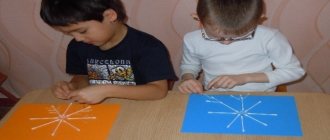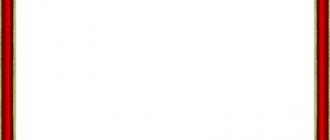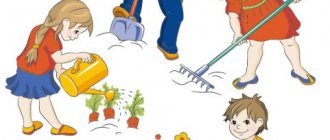MAGAZINE Preschooler.RF
Summary of an integrated lesson in the middle group on artistic and aesthetic development “Scissors came to visit us”Prepared by Oksana Aleksandrovna Malyutina
Goal: To introduce children to scissors as a tool used for cutting.
Educational objectives:
- Teach children to hold scissors correctly.
- Teach safety rules when working with scissors.
- Carry out “simple” movements with them;
Developmental tasks:
- Develop fine motor skills.
Educational tasks:
- Cultivate endurance, perseverance, and attentiveness.
- Reinforce in children the techniques of careful gluing.
Materials:
- Scissors of different types and sizes. Colored paper, glue, glue brush, poetry, finger gymnastics.
Preliminary work:
- Considering scissors of different types and sizes
- Reading poems about scissors
Progress of the lesson
The teacher asks a riddle
Made of iron, able to shear and cut. When they meet, the parts are separated.
Children: Scissors
Educator: That's right, these scissors show the box, open it, and there are different types of scissors. (Slide No. 2)
“There are different scissors in the world. All of them benefit a person: they use scissors to cut hair, fingernails and toenails, cut fabric when sewing clothes, cut out fins for fish when preparing food. (slide number 3). And children use scissors to cut out different figures from paper, from which they then make beautiful pictures. But if you play with scissors - swing them, twirl them in front of your eyes, they can get angry and prick or scratch. In general, the scissors are good. If handled correctly, they can help in many ways.
Educator: Now we will get to know the scissors better, I will hand them out to you.
TEACHER: Now look carefully at your scissors. How many rings does the scissors have?
Children: two.
TEACHER: What else are they like?
CHILDREN: On the oval, on the windows, on the sun, on the bagels, on the saucer (slide number 4).
TEACHER: How many knives do scissors have?
CHILDREN: two.
TEACHER: What do the knives look like?
CHILDREN: Like a bird with a beak, like a crocodile. (slide number 5)
TEACHER: Look how I open and close the “mouth” of the scissors.
TEACHER: We will insert our fingers into the ring. Here's a look at how (demonstration). How many fingers did I put in?
CHILDREN: two.
TEACHER: And the scissors also have an important detail - a nail. Look at him, he is connecting the scissors.
Today we will learn how to use scissors and cut paper.
TEACHER: But first I want to tell you that scissors are not a toy, you can get hurt with them. Therefore, I want to tell you about the rules for working with scissors:
- You can only take and cut with scissors with the permission of an adult.
- Do not play with scissors or swing them.
- Hold the scissors straight away from you in a horizontal position.
- Pass scissors to each other rings first
- When finished, put the scissors into the scissors box. (slide number 6)
The teacher invites the children to play with their fingers
Scissors
Initial position. Press the thumb, ring finger and little finger into the palm. Extend your index and middle fingers forward.
They either diverge or converge, imitating the movements of scissors. The palm is parallel to the table. Perform the exercise slowly at first, then speed up the pace. Make sure your fingers are straight.
I cut, I cut, I twist the fabric,
I want to learn to sew!
Educator: Now let's work with scissors. Show me how to hold scissors correctly in your hands, what movements did I show you? Try snapping scissors.
Children try to work with scissors; if they fail, the teacher takes their hand in theirs and performs the movements together with the child.
Educator: “Our scissors are tired and want to rest here. Let’s carefully collect all the scissors and put them back in the box, we will meet with them more than once.”
The children say goodbye to them. The lesson is over.
| Next > |
Learning to cut with scissors using templates
Learning to cut with scissors: the very first and simplest tasks for children. You can print out the cutting templates or replicate them by drawing similar shapes yourself.
Cutting templates “Airplanes”
The simplest tasks for learning how to cut.
Farm
Cuttings "Ladybugs"
Don’t forget the main principle when learning any new skill for a child: we move from simple to complex. These simple templates are perfect for your first cutting lessons.
Cuttings "Frogs"
Cuttings “Fruit trees”
We learn to cut with scissors, glue and recognize various geometric shapes.
Spiral template
A very beautiful and effective cutting template for children.
Cuttings "Patches"
Quest "Farmhouse"
Interesting templates - full-fledged fakes for cutting, coloring and gluing.
- Color the template details.
- Cut out the shapes at the dots.
- Glue the shapes onto the sheet, matching the corresponding numbers.
creative clippings
If difficulties may arise with ordinary cutting tasks, then cuttings “with meaning” - in fact, role-playing games - will appeal to every child.
We offer a game of being a hairdresser or manicurist!
Cut-out appliques for children
If you want to purchase a manual with cutouts or appliqués for children, pay attention to the quality of the paper (thick enough so that it is easier to cut than to tear) and the complexity of the elements for cutting with scissors (such manuals often have overly complex elements with underestimated age markings)
My personal recommendation : series with square elements. The books are colorful, the child makes up a whole story, and the work is simple, guaranteeing success. For example:
- Cutting books Applications for the little ones from Phoenix-Premier - a budget-friendly and beautiful series for learning how to cut with scissors. Marking 1+!
- Series “My first applications” from Dragonfly: a very high-quality manual with spectacular simple applications. Here and here.
Practice cutting with scissors
You can learn to cut not only paper, but also cocktail tubes, threads, old magazines, plant stems, soft plasticine, ribbons, EVA sheets ... Children over 4 years old can be offered curly scissors - learning to cut will become even more interesting!
Honing your carving skills
To hone your children's paper cutting skills, use these simple cutouts. It is better if you print them on colored paper and first cut them along the dotted lines into strips yourself.






